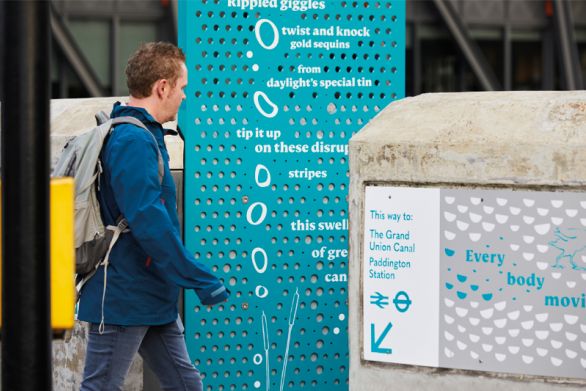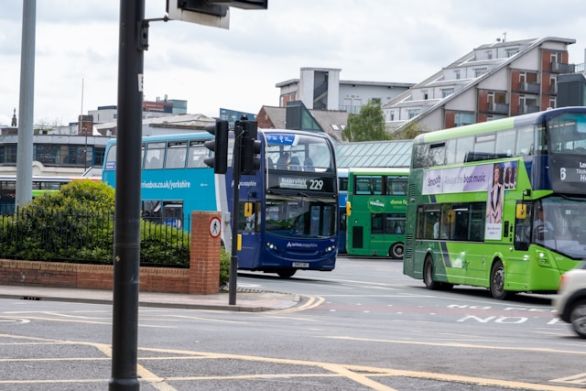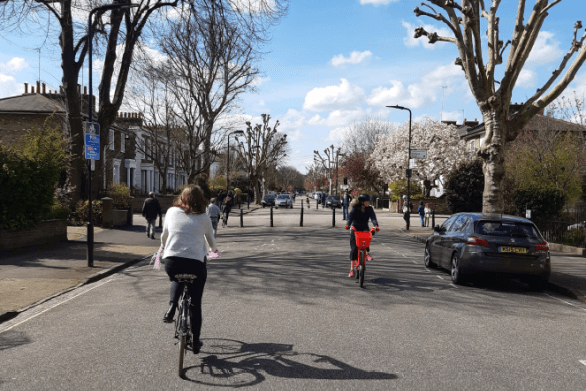Despite its name, New Road in the London Borough of Havering has a history extending back over 100 years. The road served for many years as the A13 trunk road from London to Southend but was bypassed and downgraded nearly twenty years ago. The area is now being transformed to support a new housing zone and to provide improved transport connections.
Although New Road was bypassed by the new A13 and downgraded, much of it is still a dual carriageway, creating an unwelcoming environment that is dominated by the road, and which also acts as a barrier to movement between areas to the north and south. Some specific challenges associated with the current layout include:
- The predominance of dual carriageways and the presence of large junctions is an environment that encourages high vehicle speeds and creates road safety issues.
- Existing cycling facilities are discontinuous and inconsistent, and therefore unused by cyclists.
- The walking environment is unpleasant due to street clutter as well as the speed of adjacent traffic. The many signalised crossings are indirect and inconvenient to use, requiring up to four stages to cross the road. This also makes it less attractive to walk to bus services.
- Existing green spaces at either end of New Road are largely hidden.
These findings are underlined by results from the TfL Healthy Street Check for Designers, where New Road currently only scores 37/100 with particularly low scores achieved in easiness to cross (30%) and safety perception (33%). In addition, baseline attitudinal surveys showed that only 19% of respondents agreed that ‘the streets in this area are attractive’. New Road is therefore not fit for purpose today, and even less so when the planned growth in the area is considered.
In 2016 the Greater London Authority (GLA) designated the industrial area around New Road as the Rainham and Beam Park Housing Zone, offering around 3,500 new homes, community facilities, a new school, and a new railway station.
New Road in its current form does not meet the needs of the housing zone and Havering Council has therefore embarked on an ambitious project part funded by Transport for London (TfL) and the GLA to reconfigure New Road from a legacy dual carriageway into Beam Parkway, a new city street and linear park that will support the housing zone and provide improved transport connections for all modes by creating a series of new places and green links.
The Beam Parkway scheme will, therefore, transform a 2-kilometre length of New Road into a single carriageway and the space gained will be transformed through the provision of new walking and cycling facilities as well as new landscaping and sustainable drainage systems.
Footways on both sides of the carriageway will be improved, widened and decluttered and a new two-way segregated cycle track will run along the entire length of the corridor. Floating accessible bus stops will improve access to public transport.
All side road priority junctions will be provided with continuous footway and continuous cycle lane treatments. Informal raised crossings with pedestrian refuge islands at regular intervals will improve permeability between the existing and the new neighbourhoods while encouraging lower vehicle speeds.
Dedicated lighting features will provide appropriate lighting levels along the footway and cycle track as well as along the carriageway. Seating and resting places will encourage residents to use the new pedestrian and cycle facilities. New landmarks, referencing memories and the history of the road will help people identify with the area.
Complementing these features will be an articulated landscaping and planting palette. A line of vegetated swales will be introduced along the length of Beam Parkway, separating pedestrians and cyclists from the road and providing a cleansing and drainage system for rainwater.
The existing wetland character of the Ingrebourne Marshes will be extended through the planting palette across the eastern end of the scheme. The scheme will also link into the Beam Country Park at the western end of the scheme. New trees and planting will help to improve air quality as well as provide shading and create a pleasant environment for walking and cycling. An educational ‘urban wild trail’ will increase and support biodiversity in the area.
The Beam Parkway scheme will:
- Unlock major regeneration and use opportunities to work with developers;
- Enable and encourage the use of sustainable transport;
- Reduce severance, strengthen social cohesion and improve links between communities;
- Enhance the urban realm and provide new green space;
- Reduce the negative impacts of transport on the environment and amenity;
- Contribute to improved health, and
- Provide improved access to employment and education opportunities.
The new scheme has been designed by a team led by Steer including East Architecture, Jonathan Cook Landscape Architects, Studio Dekka and Norman Rourke Pryme.
Steer has led the scheme through TfL’s Major Schemes bid process, modified to reflect the current Healthy Streets agenda. In addition to the scheme design, Steer has carried out extensive traffic modelling to ensure that the modified junctions and crossings meet the need for traffic capacity while providing significant walking and cycling benefits. Steer is now supporting Havering through procurement of a contractor to deliver the project.











